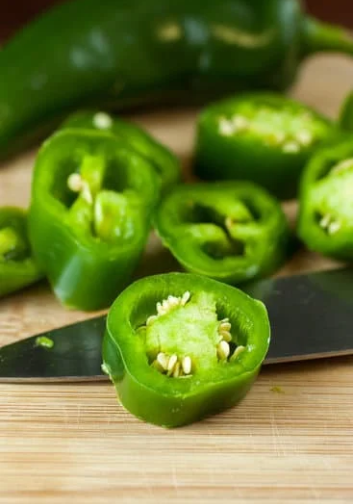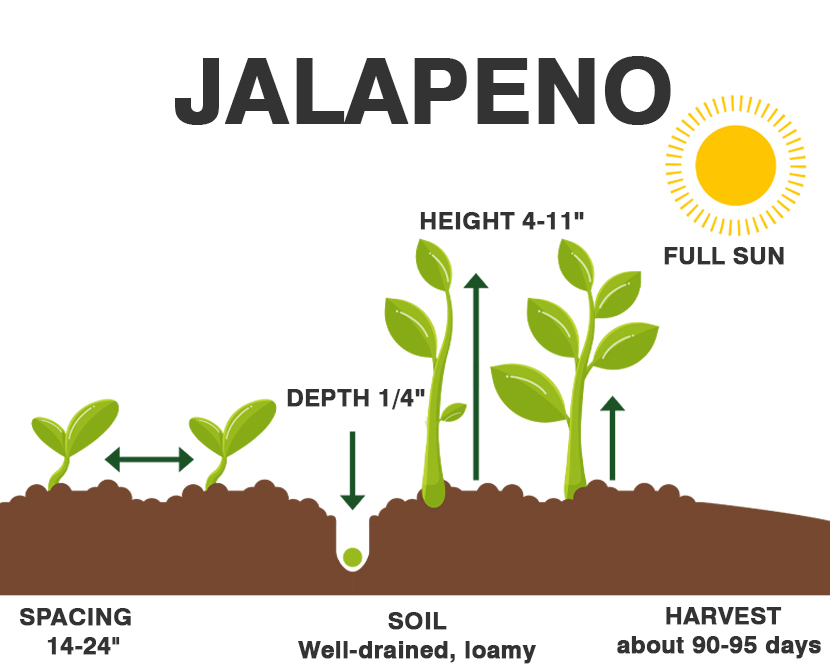Even those relatively new to hot peppers know of jalapeño peppers, but what’s interesting is the overall reputation this hot pepper has. Many people think of the jalapeño as a very spicy hot pepper, but in terms of the Scoville scale, it is merely mild to moderate. Jalapeño peppers have a Scoville heat unit range of 2,500 to 8,000 Scoville heat units (SHU). That’s mighty low compared to the hottest peppers in the world, some of which top the 1,000,000 SHU mark on the pepper scale. It’s also much milder than that cayenne pepper you have sitting on your spice rack (30,000 to 50,000 SHU).

| Common Name | Jalapeno pepper |
| Botanical Name | Capsicum annuum ‘Jalapeno’ |
| Family | Solanaceae |
| Plant Type | Perennial, vegetable |
| Size | 1–4 ft. tall, 1–2 ft. wide |
| Sun Exposure | Full sun |
| Soil Type | Moist, well-drained |
| Soil pH | Acidic, neutral |
| Bloom Time | Summer |
| Hardiness Zones | 9–11 (USDA) |

When to Plant?
This will be determined by your planting zone. There is a final frost date for each area. As a result, you can plan your gardening activities around this date. Check our Frost Dates Across North America: First & Last Frost Dates Chart. However, the date will not be the same for every plant.
How to Plant
Only home gardeners who enjoy long growing seasons in the Deep South should attempt to sow pepper seeds directly in the vegetable garden. Most of us must start our own pepper plants indoors about 8-10 weeks before transplanting, which should be done 2-3 weeks after the expected last frost.
Sow seeds ¼ inch deep in seed-starting formula
Keep the soil moist at 75 degrees F
Seedlings emerge in 10-21 days

As soon as seedlings emerge, provide plenty of light on a sunny windowsill or grow seedlings 3-4 inches beneath fluorescent plant lights turned on 16 hours per day, off for 8 hours at night. Raise the lights as the plants grow taller. Incandescent bulbs will not work for this process because they will get too hot. Most plants require a dark period to grow, do not leave lights on for 24 hours.
Seedlings do not need much fertilizer, feed when they are 3-4 weeks old using a starter solution (half strength of a complete indoor houseplant food) according to the manufacturer’s directions.
How to Cultivate
Keep weeds under control during the growing season. Weeds compete with plants for water, space, and nutrients, so control them by either cultivating often or using mulch to prevent their seeds from germinating.
Mulches also help retain soil moisture and maintain even soil temperatures. This is especially critical for peppers, as their roots may be easily damaged when weeding, and this can lead to blossom end rot.
Keep plants well-watered during the growing season, especially during dry spells. Plants need about 1-2″ of rain per week during the growing season. Use a rain gauge to check to see if you need to add water. It’s best to water with a drip or trickle system that delivers water at low pressure at the soil level. If you water with overhead sprinklers, water early in the day so the foliage has time to dry off before evening, to minimize disease problems. Keep the soil moist but not saturated.
Note that hot peppers tend to be hotter when they have less water and fertilizer. If they receive plenty of water, and they may be milder than expected.
Monitor for pests and diseases. Check with your local Cooperative Extension Service for pest controls recommended for your area.
Try planting pepper plants near tomatoes, parsley, basil, and carrots in your home vegetable garden. Don’t plant them near fennel or kohlrabi. Peppers are very colorful when in full fruit and combine well with green herbs, okra, beans, and cucumber fences in the garden bed.
If you are growing in small cells, you may need to transplant the seedlings to 3 or 4-inch pots when seedlings have at least 3 pairs of leaves before transplanting to the garden, so they have enough room to develop strong roots.
Before planting in the garden, seedling plants need to be “hardened off”. Accustom young plants to outdoor conditions by moving them to a sheltered place outside for a week. Be sure to protect them from wind and hot sun at first. If frost threatens at night, cover or brings containers indoors, then take them out again in the morning. This hardening-off process toughens the plant’s cell structure and reduces transplant shock and scalding.
How to Harvest
Harvest jalapeño peppers by pinching them carefully from the stem when they are firm and solid-colored before they turn color.
Reserve jalapeños for dishes that require very hot peppers. You can dry jalapeños, freeze them, or use them in salsas and sauces if you dare!
Learning how to grow jalapeño peppers is a great way to provide some extra zip to your food dishes. In addition, proper care of your peppers will help prevent any future jalapeño plant problems.
Jalapeños are nightshade plants like tomatoes, potatoes, and eggplant, and are vulnerable to similar diseases and pest issues. Keeping pepper plants well-watered and your garden area clean of rotting debris will help to keep pest issues to a minimum.
Cutworms, aphids, and flea beetles are common pests of the pepper plant. Spray plants with a heavy shot of water to knock off aphids or use an organic insecticide, like neem oil. Worms or caterpillars should be picked off plants and thrown away. It is a good idea to check plants daily for pests.
Hydroponics
Germination: To germinate Jalapeno pepper seeds hydroponically, soak them in warm water for 24 hours, plant them 1/4 inch deep in a small container filled with seedling mix, and keep the soil moist with consistent warmth and light. Germination should occur within 7-10 days.
pH range: The pH range for Jalapeno pepper plants is between 5.5 and 6.5. You can use a pH meter or pH testing strips to monitor the pH levels of your hydroponic system.
EC: The ideal electrical conductivity (EC) level for Jalapeno pepper plants is between 1.8 and 2.2 mS/cm. It’s important to regularly check the EC levels of your hydroponic system and make adjustments as needed to maintain this range.
PPM: The ideal parts per million (PPM) level for Jalapeno pepper plants is between 1260 and 1540.
Humidity: Jalapeno pepper plants prefer a humidity level between 40% and 60%. To achieve this level of humidity, you can use a humidifier or a dehumidifier, depending on the ambient humidity level in your growing area.
Light hours: Jalapeno pepper plants require at least 6 hours of direct sunlight or 12-14 hours of artificial light per day.
Temperature air: The air temperature for Jalapeno pepper plants is between 70°F and 80°F (21°C and 27°C) during the day and between 60°F and 70°F (16°C and 21°C) at night.
Temperature water: The ideal water temperature for Jalapeno pepper plants is between 65°F and 75°F (18°C and 24°C). To maintain the water temperature, you can use a water chiller or a water heater depending on the temperature of the room where you are growing your plants.
With these guidelines, you should be able to grow healthy plants hydroponically. Good luck, and happy growing!



